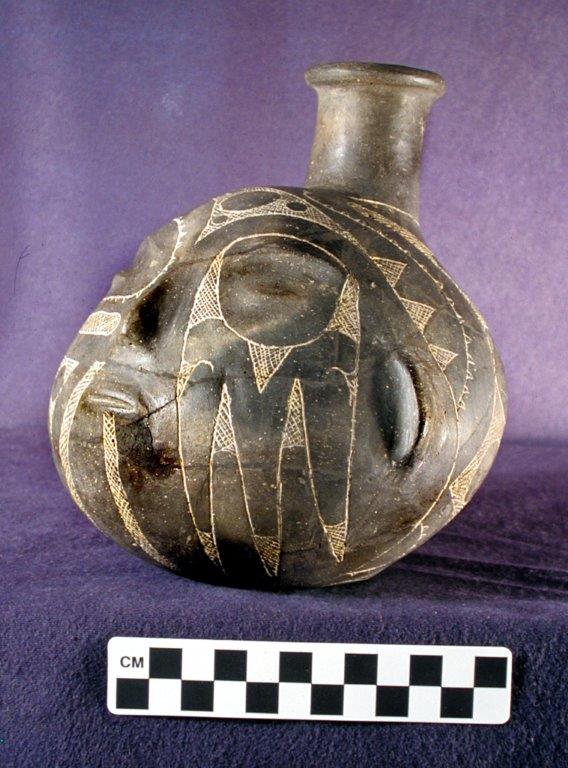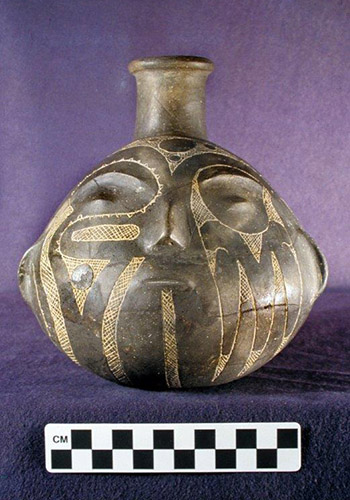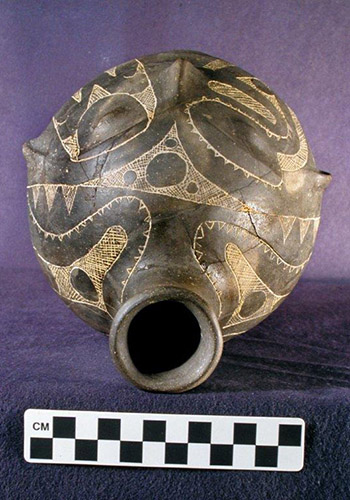
by Ann M. Early
Artifact of the Month - February 2018
Prehistoric Caddo potters in Arkansas produced elegant containers with intricate engraved decorations for centuries before American settlers arrived. This tradition contrasted with that of the Native people of eastern Arkansas who modeled containers into animal and human effigy shapes and who colored their creations with bright red, white, and black clay slips. Pictured is a rare example of a Caddo modeled head effigy with stylized and restrained facial features made in the Caddo style. The engraved decoration, usually found on bottles, bowls, and other containers, makes this a unique example of ancient Caddo ceramic art.
The engraved designs used on this vessel are common in the Ouachita River valley in southwest Arkansas where this vessel was found, except for the figure encircling the left eye. This figure can be understood as a bird wing, a raptorial bird with folded wings, a human hand, or all three simultaneously. The multilayered meanings of this symbol convey information about death, the afterlife, and the spirit world.
This bottle, made in the early 1600s, offers a look into the realm of spiritual belief as well as an example of the technical and aesthetic expertise of native Caddo potters who lived in Arkansas.
* * *
Materials: Clay, shell
Dimensions: 11.1 in, 5.5 in
Age Estimate: AD 1600–1650
Courtesy of Historic Arkansas Museum and Henderson State University Museum



Artifact of the Month Series
A first principle of archeology is that the significance of artifacts depends upon documented information about the context of their discovery. At what site was the artifact found? Can we figure out the age of the artifact? Where was it found in relation to site features (houses, trash deposits, activity areas, etc.) and the distribution of other artifacts? Only with knowledge of those facts can we assess further information about the manufacture and use of artifacts, and their role in other spheres of activity such as social organization, trade and exchange, and religious practice.
In this series, we feature select artifacts that are extraordinary both for the context of their discovery and for their unique qualities that contribute exceptionally important information about Arkansas culture and history. New artifacts will be added monthly throughout 2018. Find the list of artifacts here.
 Collections and items in our institution have incomplete, inaccurate, and/or missing attribution. We are using this notice to clearly identify this material so that it can be updated, or corrected by communities of origin. Our institution is committed to collaboration and partnerships to address this problem of incorrect or missing attribution. For more information, visit localcontexts.org.
Collections and items in our institution have incomplete, inaccurate, and/or missing attribution. We are using this notice to clearly identify this material so that it can be updated, or corrected by communities of origin. Our institution is committed to collaboration and partnerships to address this problem of incorrect or missing attribution. For more information, visit localcontexts.org.
 The Arkansas Archeological Survey is committed to the development of new modes of collaboration, engagement, and partnership with Indigenous peoples for the care and stewardship of past and future heritage collections.
The Arkansas Archeological Survey is committed to the development of new modes of collaboration, engagement, and partnership with Indigenous peoples for the care and stewardship of past and future heritage collections.
 The TK Notice is a visible notification that there are accompanying cultural rights and responsibilities that need further attention for any future sharing and use of this material. The TK Notice may indicate that TK Labels are in development and their implementation is being negotiated. For more information about the TK Notice, visit localcontexts.org.
The TK Notice is a visible notification that there are accompanying cultural rights and responsibilities that need further attention for any future sharing and use of this material. The TK Notice may indicate that TK Labels are in development and their implementation is being negotiated. For more information about the TK Notice, visit localcontexts.org.
